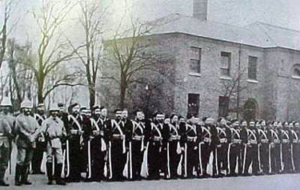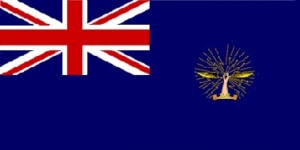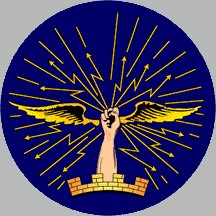In a flash, the wreck of the Royal George was destroyed. What made this particular event unique was the method used in its destruction. It was 1838 and Royal Engineers (RE) Officer C. Pasley, RE, (later General Sir C. Pasley, RE,) was successful in using electrically detonated submerged charges, thus marking the beginning of submarine mining.
The idea of defending harbours through the use of submerged mines was quick to follow this early success. Further experimentation took place and in 1863 a study was launched to report on the uses of “Floating Obstructions and Submarine Explosive Machines in the Defence of Channels.” After 5 years of study at the School of Military Engineering in Chatham, England, it was determined that the defence of harbours and ports with submarine mines was the most desirable path to follow.
Recruiting began in earnest, with the first submarine mining company Royal Engineers, 4 Company forming in 1871. Two years later a submarine mining school was established in the retired ship HMS Hood moored at Chatham. Sappers, as they were called, received five months’ general instruction and another 34 days of practical instruction on how to connect up, embark, sling, lay out and raise mines. They prepared multiple and group cables, buoys, moorings, and junction boxes, all in an effort to become fully initiated in the field of submarine mining.
Ideally, the Royal Engineers would have preferred to have enough companies of submarine miners to undertake all duties at all minefields. This proved impractical, not to mention expensive. It was decided instead to provide a company as part of a permanent garrison at each defended port and supplement these with militia submarine mining units that were trained by regular garrisons in peacetime. This was the system tried at Esquimalt.
A preliminary group of seven Royal Engineer submarine miners left England for Esquimalt on September 9, 1899. This small contingent took control of the submarine mining establishment on Signal Hill with its pier, slip, stores, shops, offices and all submarine mining equipment contained therein. The 48th Submarine Mining Company, RE, was formed at Chatham on February 1, 1900 and left for Canada on the 9th of May of that year. The 48th Company along with half of 44 (Fortress) Company Royal Engineers and a small detachment of gunners of the Royal Garrison Artillery provided an additional strength of four officers and 120 other ranks to the Esquimalt Garrison.
The company was stationed at Esquimalt until the withdrawal of the British Garrison in 1906. Over that six-year period, numerous developments of the facilities were carried out. In 1900, two 6-pounder Q.F. Hotchkiss guns were mounted at Duntze Head followed by an observing station, a test room, an engine room to supply power to the minefield, and two defence electric lights. An additional engine room was completed at Fort Rodd Hill in 1901.
Exact details of the laying of the minefield in Esquimalt are unknown. However, it likely conformed to the general British service practice of the time. The minefield would have been laid across the narrowest portion of the entrance to Esquimalt harbour, between Fisgard Lighthouse and Duntze Head. The mines “were to be connected by cable to permanently established points on shore at Duntze Head and then through buried circuits to the Test Room, where continuity and switching were monitored, and the Observing Station, where the firing of the observation mines was controlled.”
Replacement mines, spare cables and vessels used in the maintenance of the minefield were kept in a constant state of readiness at the shore establishment. Two steamships, Beryl and Topaz, were locally built for the 48th Company for minelaying and maintenance of the minefield sometime between 1902-1904. Little information exists on the use of these vessels but they certainly allowed the Company to practice more frequently and made regular inspection of the cables and mines possible.
The eventual elimination of the 48th Submarine Mining Company was the result of two changes in British naval and military policy. First came the transfer of responsibility for submarine mining from the army to the Royal Navy. Subsequently, the Royal Navy became gravely concerned about the threat from Germany in its own waters. Esquimalt was one of many Royal Navy establishments to be closed or reduced, and as a result, the 48th Submarine Mining Company was turned over to the Royal Navy, while the navy relinquished the submarine mining equipment and reduced its presence at Esquimalt.
So it was that in 1906, with the withdrawal of the British garrison from Esquimalt, the 48th Submarine Mining Company, RE, vanished. The members of the Company returned to England to be absorbed by other engineer companies; some elected to transfer to Canadian services. Although their time in Esquimalt was short, they succeeded in leaving their mark in this small area of Canada.
By Debbie Towell
Museum Curator.
Bibliography
England, Public Record Office. WO33 46 X/L 04435, Memorandum on Torpedo Defence, by Colonel W.F.D. Jervois, C.B., dated 5th April 1873;
Lovatt, Ronald. A History of the Defence of Victoria and Esquimalt: Royal Garrison Artillery Period 1899-1906;
1983. Unpublished research paper, CFB Esquimalt Naval & Military Museum archives, page 7.
See also – “Submarine Mining, Esquimalt Harbour – 1893-1905“, from the museum’s research files, available here in PDF format, author unknown.



 CFB Esquimalt Naval and Military Museum
CFB Esquimalt Naval and Military Museum CFB Esquimalt Naval and Military Museum
CFB Esquimalt Naval and Military Museum CFB Esquimalt Naval and Military Museum
CFB Esquimalt Naval and Military Museum CFB Esquimalt Naval and Military Museum
CFB Esquimalt Naval and Military Museum CFB Esquimalt Naval and Military Museum
CFB Esquimalt Naval and Military Museum CFB Esquimalt Naval and Military Museum
CFB Esquimalt Naval and Military Museum CFB Esquimalt Naval and Military Museum
CFB Esquimalt Naval and Military Museum CFB Esquimalt Naval and Military Museum
CFB Esquimalt Naval and Military Museum CFB Esquimalt Naval and Military Museum
CFB Esquimalt Naval and Military Museum CFB Esquimalt Naval and Military Museum
CFB Esquimalt Naval and Military Museum CFB Esquimalt Naval and Military Museum
CFB Esquimalt Naval and Military Museum CFB Esquimalt Naval and Military Museum
CFB Esquimalt Naval and Military Museum CFB Esquimalt Naval and Military Museum
CFB Esquimalt Naval and Military Museum CFB Esquimalt Naval and Military Museum
CFB Esquimalt Naval and Military Museum